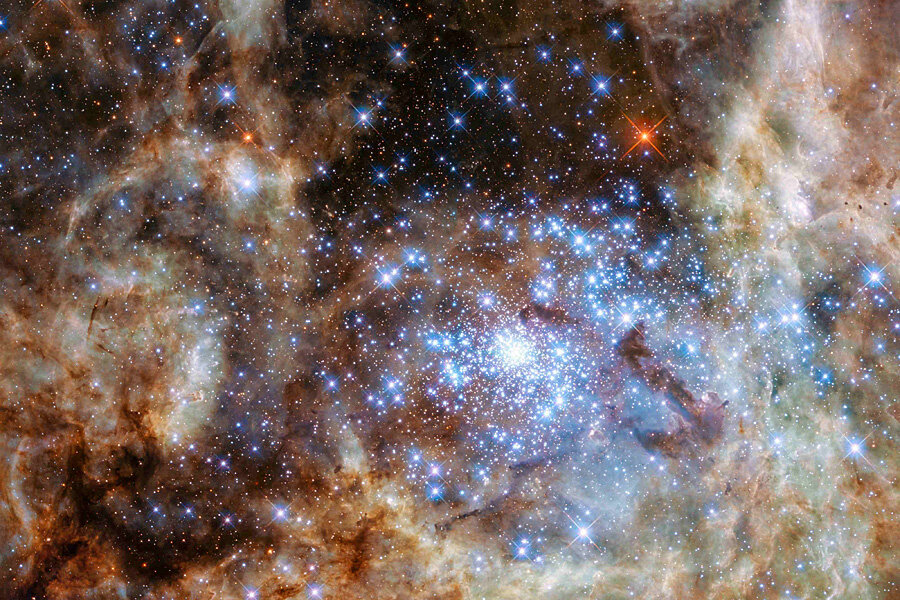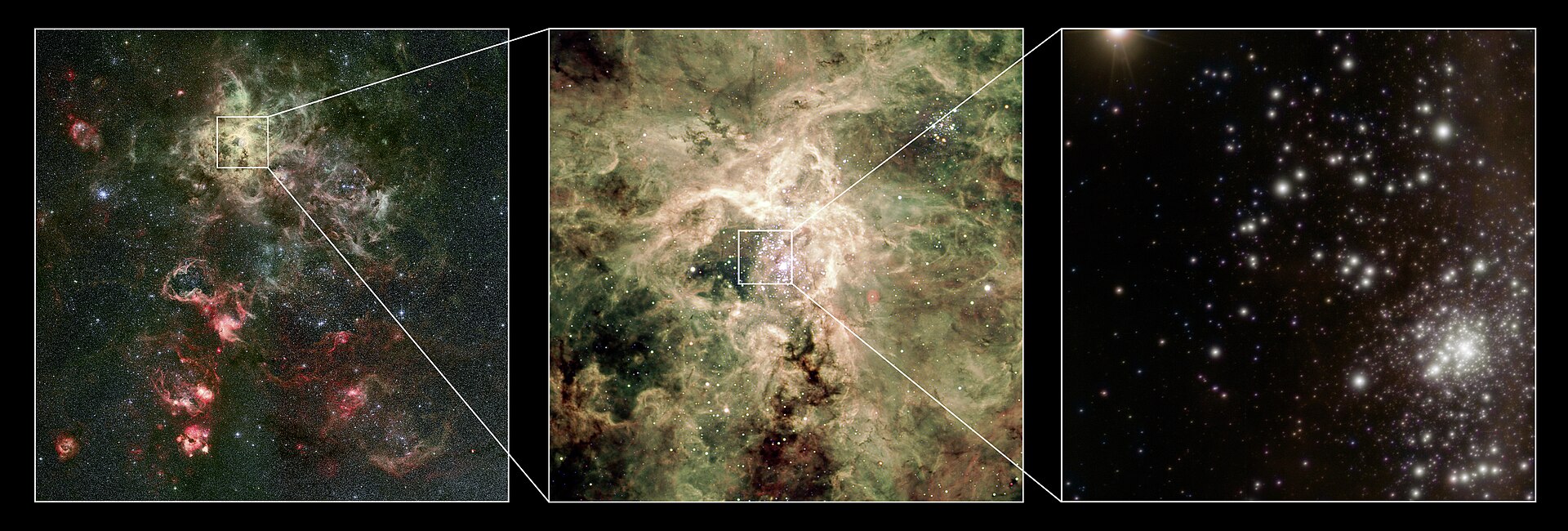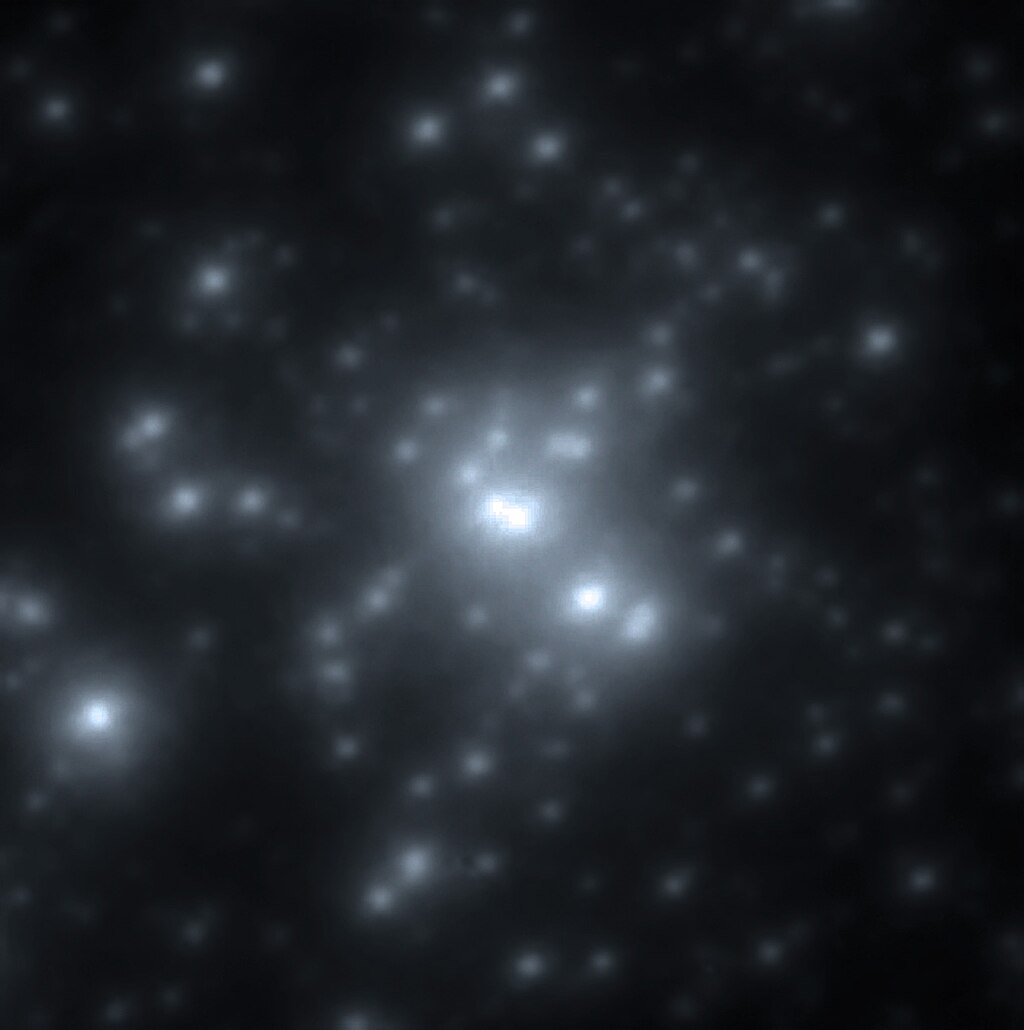Page 1 of 1
APOD: The Tarantula Nebula from SuperBIT (2023 Apr 27)
Posted: Thu Apr 27, 2023 4:05 am
by APOD Robot
 The Tarantula Nebula from SuperBIT
Explanation: The Tarantula Nebula
The Tarantula Nebula from SuperBIT
Explanation: The Tarantula Nebula, also known as 30 Doradus, is more than a thousand light-years in diameter, a giant star forming region within nearby satellite galaxy the
Large Magellanic Cloud. About 160 thousand light-years away, it's the largest, most violent star forming region known in the whole Local Group of galaxies. The cosmic arachnid is near the center of this spectacular image taken during the
flight of SuperBIT (Super Pressure Balloon Imaging Telescope), NASA's balloon-borne 0.5 meter telescope
now floating near the edge of space.
Within the well-studied Tarantula (NGC 2070), intense radiation, stellar winds and supernova shocks from the central young cluster of massive stars, cataloged as
R136, energize the nebular glow and shape the spidery filaments.
Around the Tarantula are other star forming regions with young star clusters, filaments, and blown-out
bubble-shaped clouds. SuperBIT's wide field of view spans over 2 degrees or 4 full moons in the southern
constellation Dorado.
Re: APOD: The Tarantula Nebula from SuperBIT (2023 Apr 27)
Posted: Thu Apr 27, 2023 5:33 am
by Ann
The Tarantula Nebula from SuperBIT
Image Credit: SuperBIT, NASA
When I first saw this image, I was unimpressed. I was, like, come on, haven't we seen hundreds of pictures of the Tarantula Nebula? What's so special about this one?
But when I started searching for pictures that would do a better job of showing the Tarantula Nebula than the SuperBIT one, I was humbled.
What I found was closeups of the R136 region:
Then there were "full" images of the Tarantula that nevertheless left something to be desired (to me at least):
I really do recommend the sequence of images below, but of course it is always much easier to show things with several images rather than one:
So, okay! Today's APOD does a more than acceptable job of bringing out both the R136a star cluster, the bright pink nebulosity surrounding the great cluster and the outer faint tarantula-shaped nebula surrounding the bright central parts. On top of that, the colors are okay, although the green stars are not my favorites.
You did an okay job then, SuperBIT! Because photographing the Tarantula, even for professional telescopes, is harder than I had realized.
Ann
Re: APOD: The Tarantula Nebula from SuperBIT (2023 Apr 27)
Posted: Thu Apr 27, 2023 6:25 am
by daddyo
Wow that telescope can float for 3 months, what a neat idea. I just watched a live presentation of a similar telescope that targeted the UV spectrum on short flights, which was said has hardly been imaged at all.
Re: APOD: The Tarantula Nebula from SuperBIT (2023 Apr 27)
Posted: Thu Apr 27, 2023 11:06 am
by AVAO
Ann wrote: ↑Thu Apr 27, 2023 5:33 am
...
"You did an okay job then, SuperBIT! Because photographing the Tarantula, even for professional telescopes, is harder than I had realized."
Ann
ThanX Ann
Well. For me, the question arises whether I really need a balloon for this too ,-)
https://www.youtube.com/watch?v=nOHc4u5PwHY
https://www.vikaschander.com/ngc-2070-t ... la-nebula/
Re: APOD: The Tarantula Nebula from SuperBIT (2023 Apr 27)
Posted: Thu Apr 27, 2023 1:04 pm
by Ann
Say what, AVAO? Were
you involved in creating today's APOD?

Ann
Re: APOD: The Tarantula Nebula from SuperBIT (2023 Apr 27)
Posted: Thu Apr 27, 2023 4:23 pm
by VictorBorun
How come the brightest stars are the reddest?

- SuperBIT_tarantula-.png (91.37 KiB) Viewed 3756 times
Re: APOD: The Tarantula Nebula from SuperBIT (2023 Apr 27)
Posted: Thu Apr 27, 2023 5:26 pm
by Ann
VictorBorun wrote: ↑Thu Apr 27, 2023 4:23 pm
How come the brightest stars are the reddest?
This cluster is old enough that the most massive (and thus brightest) stars have turned into red giants.
R136a (the central cluster powering the entire Tarantula Nebula) is much younger. There are no red giants in it. But you can't tell the color of the stars of R136a in the APOD. That power cluster is nestled among the brightest strands of pink nebulosity and overwhelmed by the brilliant pink nebular strands in this image.
Ann
Re: APOD: The Tarantula Nebula from SuperBIT (2023 Apr 27)
Posted: Thu Apr 27, 2023 7:14 pm
by VictorBorun
I wonder if they used parachutes to send this APOD down to the ground.
It is not terabyte-heavy, but if it was among a terabyte-heavy panoram…
Re: APOD: The Tarantula Nebula from SuperBIT (2023 Apr 27)
Posted: Thu Apr 27, 2023 8:22 pm
by VictorBorun
Ann wrote: ↑Thu Apr 27, 2023 5:26 pm
VictorBorun wrote: ↑Thu Apr 27, 2023 4:23 pm
How come the brightest stars are the reddest?
This cluster is old enough that the most massive (and thus brightest) stars have turned into red giants.
R136a (the central cluster powering the entire Tarantula Nebula) is much younger. There are no red giants in it. But you can't tell the color of the stars of R136a in the APOD. That power cluster is nestled among the brightest strands of pink nebulosity and overwhelmed by the brilliant pink nebular strands in this image.
Ann
so this is real. Wow
Re: APOD: The Tarantula Nebula from SuperBIT (2023 Apr 27)
Posted: Fri Apr 28, 2023 3:47 am
by Ann
I didn't check out your second link before I answered you. That picture by Vikas Chander is stunning!!


Again, I have to ask you, did you have anything to do with the SuperBIT/Tarantula Nebula APOD?
Ann
Re: APOD: The Tarantula Nebula from SuperBIT (2023 Apr 27)
Posted: Fri Apr 28, 2023 3:32 pm
by Christian G.
Ann wrote: ↑Thu Apr 27, 2023 5:33 am
SuperBIT_tarantula_1024[1].png
The Tarantula Nebula from SuperBIT
Image Credit: SuperBIT, NASA
When I first saw this image, I was unimpressed. I was, like, come on, haven't we seen hundreds of pictures of the Tarantula Nebula? What's so special about this one?
But when I started searching for pictures that would do a better job of showing the Tarantula Nebula than the SuperBIT one, I was humbled.
What I found was closeups of the R136 region:
Then there were "full" images of the Tarantula that nevertheless left something to be desired (to me at least):
I really do recommend the sequence of images below, but of course it is always much easier to show things with several images rather than one:
So, okay! Today's APOD does a more than acceptable job of bringing out both the R136a star cluster, the bright pink nebulosity surrounding the great cluster and the outer faint tarantula-shaped nebula surrounding the bright central parts. On top of that, the colors are okay, although the green stars are not my favorites.
You did an okay job then, SuperBIT! Because photographing the Tarantula, even for professional telescopes, is harder than I had realized.
Ann
That center cluster is thought to contain one of the most massive and luminous stars known, R136a1, I wonder if it can be identified in those images.
(It's always fun to look at such images and be able to say "oh and this innocent-looking little star right here is five million times brighter than the sun!")
Re: APOD: The Tarantula Nebula from SuperBIT (2023 Apr 27)
Posted: Fri Apr 28, 2023 5:22 pm
by Ann
Chris Alex wrote: ↑Fri Apr 28, 2023 3:32 pm
Ann wrote: ↑Thu Apr 27, 2023 5:33 am
I really do recommend the sequence of images below, but of course it is always much easier to show things with several images rather than one:
Ann
That center cluster is thought to contain one of the most massive and luminous stars known, R136a1, I wonder if it can be identified in those images.
(It's always fun to look at such images and be able to say "oh and this innocent-looking little star right here is five million times brighter than the sun!")
Maybe you can match the rightmost panel in the "three-panel image" with the ESO closeup of R136Ia beside it (or, depending on your screen, below it)?
Ann
Re: APOD: The Tarantula Nebula from SuperBIT (2023 Apr 27)
Posted: Fri Apr 28, 2023 7:01 pm
by Christian G.
Ann wrote: ↑Fri Apr 28, 2023 5:22 pm
Chris Alex wrote: ↑Fri Apr 28, 2023 3:32 pm
Ann wrote: ↑Thu Apr 27, 2023 5:33 am
I really do recommend the sequence of images below, but of course it is always much easier to show things with several images rather than one:
Ann
That center cluster is thought to contain one of the most massive and luminous stars known, R136a1, I wonder if it can be identified in those images.
(It's always fun to look at such images and be able to say "oh and this innocent-looking little star right here is five million times brighter than the sun!")
Maybe you can match the rightmost panel in the "three-panel image" with the ESO closeup of R136Ia beside it (or, depending on your screen, below it)?
Ann
Yes, I believe I can see it now! Thanks for your help.
Re: APOD: The Tarantula Nebula from SuperBIT (2023 Apr 27)
Posted: Sat Apr 29, 2023 1:14 pm
by VictorBorun
Ann wrote: ↑Fri Apr 28, 2023 5:22 pm
Chris Alex wrote: ↑Fri Apr 28, 2023 3:32 pm
That center cluster is thought to contain one of the most massive and luminous stars known, R136a1, I wonder if it can be identified in those images.
(It's always fun to look at such images and be able to say "oh and this innocent-looking little star right here is five million times brighter than the sun!")
Maybe you can match the rightmost panel in the "three-panel image" with the ESO closeup of R136Ia beside it (or, depending on your screen, below it)?
Ann
...
Re: APOD: The Tarantula Nebula from SuperBIT (2023 Apr 27)
Posted: Sat Apr 29, 2023 1:27 pm
by VictorBorun
 The Tarantula Nebula from SuperBIT
The Tarantula Nebula from SuperBIT




